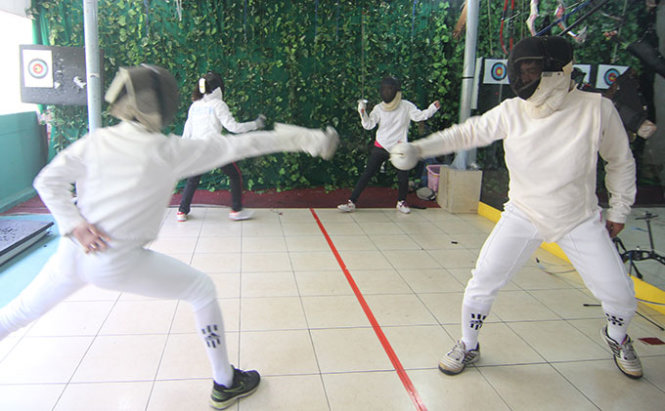More people, including women, in Ho Chi Minh City have taken up fencing – the practice of fighting with slender swords – which has become popular with urban youths in recent years.
At 7:00 pm, the 80m² hall on the third floor of the Ho Chi Minh City Youth Culture House in District 1 was boisterous with the commotion and clanking sounds of metal.
The fencers are totally engrossed in their practice, donning their specialized white protective clothing that includes a safety helmet, two layers of thick coating, and a pair of gloves,.
The swords are so thin that viewers can hardly make them out in photos.
The commotion stopped most passers-by, who are captivated by the fencers’ brisk movements and wonder if the swords are dangerous.
Fencing, which is an Olympic sport, is best practiced in countries with a temperate climate.
During their first practice sessions, fencers learn how to move their feet, which account for about half of the sport’s movements.
The lighter the fencers’ foot movements are, the higher their chance of winning get.
They then go on to learn how to maneuver their swords, move forward to thrust the swords, and figure out what their opponents are thinking to boost their winning possibility.
It takes a persistent practitioner around four sessions to grasp the sport’s basics.
The last minutes of the sessions are the most boisterous, as the fencers divide into pairs and practice dueling.
A fencing match typically lasts five minutes. The “weapon” is called an “épée,” which is a French word to denote the modern derivative of the dueling sword.
According to Wikipedia, as a thrusting weapon the “épée” is similar to a “foil,” but it has a stiffer blade with a triangular cross-section and a V-shaped groove called a fuller.
It has a larger bell guard and is heavier as well. A “foil” is usually preferred by female fencers, as it is easier to maneuver.
Both the “épée” and “foil” are not dangerous, as they have no blades.
A tiny electronic contact attached to the sword tip emits a sound whenever it hits the opponent so that points are calculated.
The valid target area is divided into four areas and restricted to the fencer’s upper body, half spanning to his/her neck.
According to Hoang Anh, chair of the VietnamFunClub, based at the Ho Chi Minh City Youth Culture House and District 5 Cultural Center, regular fencing practice improve players’ stamina, patience, wits, and courage.
“Fencing is really intriguing, as it requires players to use both their physical and brain power. Excelling players are supposed to keenly observe their opponents, not by looking into their eyes or limbs but by watching them as a whole. They sometimes need to feign to divert their opponents’ attention, or make calculated guesswork of what their rivals are planning to do,” Anh explained.
Hoang Nam, 22, who has practiced the sport as a group leader at the VietnamFunClub for one year now, showcased his attack strikes, including jumping forward on his stronger leg and making sharp sword strokes in the air.
“The maneuver is not very technically demanding, as skilled players also attack on their weaker leg to trick their opponent,” Nam said.
Fencing appeals to both males and females alike.
Thien An is drawn to the sport for its novelty and lower technical requirements.
“Fencing builds up my flexibility, agility, and stamina. I gradually draw out my own experience on attack and defense,” the 24-year-old woman said.
Doan Thi Le, another female player, said she ached all over after the first practice sessions, but now the workout has considerably boosted her stamina and inner strength.
One of the sport’s main appeals lies in its advanced maneuvers.
Nam and Anh – of the VietnamFunClub – keep updating themselves on new maneuvers with increasing difficulty and then show them to other players.
More technically challenging maneuvers include moving mostly with the weaker leg, training for lighting-speed reflexes, feigning fatigue to trick opponents, and guessing their next moves.
“We keep improving our skills each day, which also helps enhance our patience and overcome our shyness. I feel all my work-related stress and fatigue vanish into thin air after each practice session,” Nam said.
Those interested can enroll in fencing courses available at the Ho Chi Minh City Youth Culture House, at 4 Pham Ngoc Thach Street, District 1; or foreigner-packed Phu My Hung in District 7.
Tuition is around VND200,000 (US$10) for four sessions per month.
Like us on Facebook or follow us on Twitter to get the latest news about Vietnam!



















































